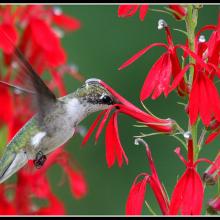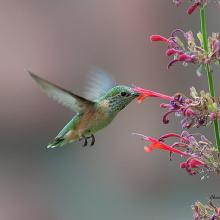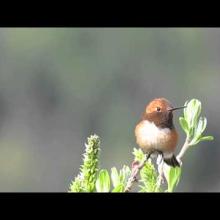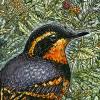

Join BirdNote tomorrow, November 30th!
Illustrator David Sibley and actor H. Jon Benjamin will face off in the bird illustration battle of the century during BirdNote's Year-end Celebration and Auction!
What bird can fly straight up and down, backward and forward, and even upside down? A hummingbird can do all this -- and fly up to 75 miles an hour. And most amazing of all? This bird can slow from 25 miles an hour to a dead stop in a space no longer than your index finger! Learn more about this Rufous Hummingbird and how to attract hummingbirds to your yard in Related Resources below.
BirdNote ®
Hummingbirds Are Mighty Puffballs
Adapted from a script written by Frances Wood
This is BirdNote!
We’re hearing the sound of a male Hummingbird.
[Whirring of wings of an Anna’s Hummingbird]
When naturalist A.R. Ammons wrote, “birds are flowers flying, and flowers are perched birds,” he may have had hummingbirds in mind. Their eye-catching iridescence sparkles in the sun.
One hummingbird commonly seen west of the Rockies is the Rufous Hummingbird. East of the Rockies, you’ll see the Ruby-throat.
The hummingbird is the only bird that can truly hover. It manages this by flapping its wings 20 to 80 times a second. [Sound of whirring wings of Anna’s Hummingbird]It can fly straight up and down. Backwards and forwards. Or upside down. And up to 75 miles an hour. But don’t worry, it won’t run into you. This bird can slow down from 25 miles an hour to a dead stop in a space no longer than your index finger.
And even if it did collide with something, it isn’t likely to cause much damage: this mighty puffball weighs less than two dimes.
[Repeat hummingbird sound, continue until end]
###
Sounds of the Rufous Hummingbird provided by The Macaulay Library of Natural Sounds at the Cornell Lab of Ornithology, Ithaca, New York. “J” display and perched call recorded by G.A. Keller; wing whirring by A.A. Allen.
Ambient sound track provided by C. Peterson
Producer: John Kessler
Executive Producer: Chris Peterson
© 2009-2017 Tune In to Nature.org March 2017 / 2019 Narrator: Michael Stein
ID # 030805RUHU RUHU-01c











